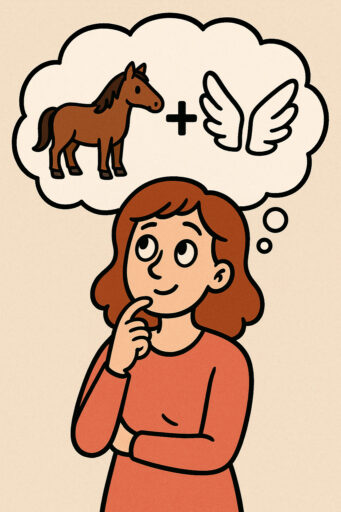I always say that humans are not all that creative; even our most fantastical creations are nothing more than rehashes of things that we experience from the world around us. A unicorn is simply a horse with a horn attached to it.
That being said, it should be noted that the faculty of creativity is still in itself real, and that its function extends beyond the mere manufacture of outlandish creatures such as unicorns and griffins. In particular, creativity can be thought of as the faculty that bridges the gap between the known and the unknown. If, for example, a person speaks to me with a word that I do not know, and I am forced to infer its meaning from tone, speaker, and context, creativity must determine the direction of my presumptive wit. Perhaps the data available to me could suppose either that this word means “friend” or “foe,” and nothing in particular gives me a conclusive reason to opt for one over the other, then creativity must bridge the gap by evaluating the situation in light of the whole of my thoughts and experiences. This example is somewhat contrived, of course, because it assumes an absolute objective equality of options, which may not really exist and may also not be strictly necessary before the operation of creativity.
Nevertheless, this example does point to a real possibility inasmuch as it is precisely the kind of situation that must be faced by artificial intelligence. When I use a word with two vastly different meanings (e.g. “heroine”), it does little good for a computer to simply decide the meaning based on a dictionary, even if it contains a statistic indicating how common one meaning is over the other. There’s always the chance that I am using the less-common meaning (which, in this case, is the original and more appropriate meaning). Accordingly, this analysis of the faculty of creativity is relevant precisely because it is—in this aspect, at least, which likely does not represent the whole of what “creativity” signifies—precisely what an artificial intelligence needs to reproduce. In fact, such creativity is simulated by today’s large language models (LLMs) such as ChatGPT. More about this later.

The above example of human creativity is noteworthy for many reasons. In the first place, it does not in its essence differ from the more banal example of creativity as a faculty of concocting fantastical creatures; in both cases, it is a faculty that takes into account a vast array of experiences and chooses some according to some perceived relevance and interrelation in order to combine them into an appropriate result. Hence creativity gave birth to the pegasus not only because the mind sought something fantastical—something that did not exist—but also because the elements for such a creation were already within the scope of the mind’s repertoire of experiences and objects. Moreover, creativity placed these objects together not by mere randomness—though some randomness may, at least in some sense, have been involve—but rather because the faculty perceived the elements (horse and wings) as having some possible relevance or relation to one another. This may amount to nothing more then, “Hey, wouldn’t it be cool if a horse had wings?” Still, it is this inner relation between the concepts that made them the object of creativity’s machinations.
In addition, this means that creativity is most noteworthy for the way in which it perceives varied things in light of a broader whole. It does not merely compare this or that experience to some input. First and foremost, it perceives such input in light of the collective whole of the person’s experiences and it is in that light that it becomes capable of comparing it to this or that experience in particular. One might suppose that such a holistic approach is what sets creativity apart from LLMs, inasmuch as a computer is essentially linear in its operations. Still, it is not altogether clear that creativity’s awareness of the collective whole signifies something more than the fact that the mind is an analog computer rather than a digital one. Inasmuch as it clearly derives from the experience of consciousness as such—which is consciousness of the whole simultaneous with consciousness of the particular—one might argue that creativity has a certain spiritual significance in this way. However, setting the strictly theological perspective aside, one cannot be entirely certain that the computational aspect of creativity cannot be emulated by artificial computers.
Large language models—apart from the hype—thus complicates any sheer distinction between human creativity and the presumptive calculations of artificial intelligence.

For a traditional AI based on simple algorithms, the appearance of creativity often boils down to little more than randomness. I faced such situations in programming a game called Dark Deeds. If I want an AI-controlled enemy to follow a player without explicitly informing the enemy where the player has gone, then I have to give it some means of calculating its options. When all options are equal, then a random number generator must decide which to try. If successful, the player will think that some intelligence has driven the enemy to act as it did. However, all “intelligence” here merely boils down to quantitative calculations supplemented by a degree of randomness.
Large language models, on the other hand, simulates creativity’s contact with the whole of experience. Going back to the language example, if you feed the AI a million examples of the use of “heroine,” it can determine not only a statistic as to the use of each meaning but also a sense of the context in which each meaning tends to appear. The human brain does this very thing when learning language. A computer may have the benefit of a broader range of examples, but like the human mind it also suffers from input bias. If my upbringing never makes me aware of the alternate meaning of the word, then I will likely misunderstand it when entering a new context. In the same way, LLMs can take in biases from the processed data. The data set can easily lean in a misleading direction, e.g. because of economic factors (a data set of published works is more likely to contain works from those privileged enough to be published) or because of the biases of humans who consciously or unconsciously curated beforehand. (In this sense, an AI can even produce “racist” responses.)
A more advanced AI thus does not rely so strictly on randomness, yet that does not mean that a lack of randomness is a strict indicator of intelligence. On the one hand, it does not seem that LLMs remove all randomness in their calculations. After all, two identical queries are unlikely to receive the same identical response. At some point it is likely that a random number is used to furnish greater variance in responses. On the other hand, it is also not clear that human creativity functions altogether without randomness.
In the end, therefore, the role of meaningless randomness does not necessarily negate the real significance of creativity. Put another way, creativity is not reducible to randomness. Creativity is first and foremost not random; it is a calculative intake and awareness of the comprehensive whole, within which the particular becomes visible in a new way and according to new relationships. Such a definition can illustrate how profoundly LLMs can indeed simulate human creativity. Differentiating human creativity and the creativity of LLMs will have to wait for another day.
